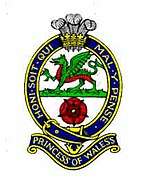Princess of Wales's Royal Regiment
| Princess of Wales's Royal Regiment (Queen's and Royal Hampshires) | |
|---|---|
 Cap Badge of the Princess of Wales's Royal Regiment | |
| Active | 9 September 1992 – present |
| Allegiance |
|
| Branch |
|
| Type | Line Infantry |
| Role |
1st Battalion — Armoured Infantry 2nd Battalion — Light Infantry 3rd Battalion — Army Reserve 4th Battalion — Army Reserve |
| Size | Four battalions |
| Part of | Queen's Division |
| Garrison/HQ |
RHQ - London 1st Battalion - Paderborn, Germany 2nd Battalion - Cottesmore 3rd Battalion - Canterbury 4th Battalion - Crawley |
| March |
Quick - The Farmer's Boy/Soldiers of the Queen Slow - The Minden Rose |
| Commanders | |
| Colonel in Chief | HM Queen Margrethe II of Denmark [1] |
| Insignia | |
| Tactical recognition flash |
 |
| Arm badge |
Tiger From the Royal Hampshire Regiment |
| Abbreviation | PWRR |

The Princess of Wales's Royal Regiment (or PWRR, also known as 'the Tigers') is the senior English line infantry regiment of the British Army, part of the Queen's Division, and second only in line infantry order of precedence to the Royal Regiment of Scotland.
History
The Princess of Wales's Royal Regiment was formed on 9 September 1992 by the amalgamation of the Queen's Regiment and the Royal Hampshire Regiment and holds the earliest battle honour in the British Army (Tangier 1662–80).[2] Through its ancestry via the Queen's Royal Regiment (West Surrey) (2nd Regiment of Foot), the PWRR is the most senior English line infantry regiment. The current regiment was named in honour of Diana, Princess of Wales.[3]
The regiment was formed to act as the county regiment for the following areas:[2]
Upon its creation, the Princess of Wales and the Queen of Denmark were Allied Colonels-in-Chief of the PWRR. When the Princess divorced the Prince of Wales, she resigned as Colonel-in-chief and the Queen of Denmark has remained its Colonel-in-Chief since.[4]
The 1st Battalion served a seven-month tour of Iraq in 2004 with a second tour following in 2006, and finally a tour in 2009 where the battalion was split between Afghanistan and Iraq (last combat operation in Iraq). Many of the operations carried out by the battalion during the first tour were named after stations on the London Underground.[5] Elements of 1 PWRR helped train the Iraqi National Army and oversaw the withdrawal of UK Forces from Basra.[6] 1st Battalion was deployed to Afghanistan again in August 2011 to form the nucleus of the Police Mentoring Advisory Group (PMAG) with individual companies detached to other battlegroups around Helmand province.[7] The 1st Battalion under Army 2020 will move from Paderborn, Germany to be stationed at Bulford Camp.[8][9][10]
The regiment's 2nd Battalion were based in Shackleton Barracks, Northern Ireland, the last resident battalion deployed in this role under Operation Banner. After two years at Alexandria Barracks in Dhekelia in Cyprus, they moved to Woolwich Garrison, London, to take up a public duties role in August 2010, a role they performed for three years.[11] 2nd Battalion deployed to Cyprus again in 2014.[12] It remains one of the infantry units rotating between the UK and British Forces Cyprus.[13] In August 2017, the Battalion returned to the UK, based at Kendrew Barracks in Cottesmore, where they are reconfiguring two companies into a Light Mechanised Infantry force.[14]
Structure
The regimental headquarters (RHQ) is at the Tower of London, whilst the regiment itself comprises four battalions:
- 1st Battalion — Armoured Infantry serving with 20th Armoured Infantry Brigade[15]
- Structure[16]
- HQ Company
- A Company
- B Company
- C Company
- Y (Fire Support) Company
- Reconnaissance Platoon
- Anti-Tank Platoon
- Mortar Platoon
- Communications Platoon
- 2nd Battalion — Light Infantry serving in UK[17] The battalion will convert to a Specialised Infantry battalion, to provide an increased contribution to countering terrorism and building stability overseas.[18]
- Structure[19]
- HQ Company
- A Company
- B Company
- C Company
- Z (Fire Support) Company
- Reconnaissance Platoon
- Anti-Tank Platoon
- Mortar Platoon
- Communications Platoon
- D Company
- Signals Platoon
- Intelligence Platoon
- Motor Transport Platoon
- 3rd Battalion — Army Reserve Light Infantry serving with 7th Infantry Brigade and Headquarters East[20]
- Structure[21]
- HQ Company (V)
- A Company (V)
- B Company (V)
- C Company (V)
- D Company (V)
- 4th Battalion — Army Reserve (on 15 December 2016 the Defence Secretary announced that a second reserve battalion of the PWRR would be formed). It will be under operational command of 7th Infantry Brigade.[22][23]
Regimental museum
The Queen's & Princess of Wales's Royal Regiment Regimental Museum is based at Dover Castle.[24]
Victoria Cross and other decorations
Medals and awards awarded to the regiment's 1st Battalion for their service during operations in Iraq in 2004 included a Victoria Cross, two Distinguished Service Orders, two Conspicuous Gallantry Cross, one Member of the Order of the British Empire for gallantry, ten Military Crosses, and seventeen were Mentioned in Despatches, making the regiment the most highly decorated serving regiment in the British Army at that time.[5]
Private Johnson Beharry of the 1st Battalion, PWRR was awarded the Victoria Cross for his actions during his unit's deployment to Amarah, near Basra.[25]
Whilst attached to the 1st Battalion, Michelle Norris of the Royal Army Medical Corps became the first woman to be awarded the Military Cross following her actions on 11 June 2006.[26]
Battle honours

- (combined battle honours of the Queen's Regiment, and the Royal Hampshire Regiment, with the following emblazoned:)
- Regimental Colours1: Tangier 1662-80, Namur 1695, Gibraltar 1704-5, Blenheim, Ramillies, Oudenarde, Malplaquet, Dettingen, Minden, Louisburg, Guadeloupe 1759, Quebec 1759, Belleisle, Tournay, Barrosa, Martinique 1762, Seringapatam, Maida, Corunna, Talavera, Albuhera, Almaraz, Vittoria, Peninsula, Punniar, Moodkee, Sobraon, Inkerman, Sevastopol, Lucknow, Taku Forts, Pekin 1860, New Zealand, Afghanistan 1879-80, Nile 1884-85, Burma 1885-87, Relief of Ladysmith, Paardeberg, South Africa 1899-1902, Korea 1950-51
- Queen's Colours: Mons, Retreat from Mons, Aisne 1914, Ypres 1914 '15 '17 '18, Hill 60, Festubert 1915, Somme 1916 '18, Albert 1916 '18, Arras 1917 '18, Cambrai 1917 '18, Hindenburg Line, Italy 1917–18, Doiran 1917-18, Landing at Helles, Gaza, Jerusalem, Palestine 1917–18, Kut al Amara 1915 '17, Mesopotamia 1915–18, North West Frontier India 1915 1916-17, Dunkirk 1940, Normandy Landing, Caen, Rhine, North-West Europe 1944-45, Abyssinia 1941, El Alamein, Tebourba Gap, Hunt's Gap, Longstop Hill, North Africa 1940–43, Sicily 1943, Salerno, Anzio, Cassino, Gothic Line, Italy 1943-45, Malta 1940–42, Malaya 1941–42, Hong Kong, Defence of Kohima, Burma 1943–45
- 1. also emblazoned:
- The Naval Crown superscribed "1st June 1794" - from the Queen's Royal Regiment (West Surrey)
- The Sphinx superscribed "Egypt" - from the Queen's Royal Regiment (West Surrey) & Queen's Own Royal West Kent Regiment
- The cypher of Queen Catherine, (wife of Charles II), intertwined/reversed letter "C" at the base of the laurel wreath from The Queen's Royal Regiment (West Surrey), in memory of the raising of the Regiment in 1661 when sent to garrison Tangier, part of Catherine of Braganza's dowery
- The Royal Tiger superscribed "India" - from the Royal Hampshire Regiment
Order of precedence
| Preceded by Royal Regiment of Scotland |
Infantry Order of Precedence | Succeeded by Duke of Lancaster's Regiment |
Lineage
Alliances

















See also
| Wikimedia Commons has media related to Princess of Wales's Royal Regiment. |
References
- ↑ "The Princess of Wales' Royal Regiment (Queen's and Royal Hampshires) 1992 - Today". queensroyalsurreys.org.uk. Retrieved 12 September 2015.
- 1 2 "The Princess of Wales's Royal Regiment". Ministry of Defence. Retrieved 23 May 2014.
- ↑ "Princess of Wales's Royal Regiment retraces its history". BBC. 28 April 2012. Retrieved 30 April 2016.
- ↑ "No. 52834". The London Gazette (Supplement). 13 February 1992. p. 2581.
- 1 2 Mills, Dan (2007). Sniper One: The Blistering True Story of a British Battle Group Under Siege. Penguin. ISBN 978-0-7181-4994-9.
- ↑ "British soldier killed in Basra shooting". The Telegraph. 12 February 2009. Retrieved 23 May 2014.
- ↑ "Princess of Wales's Royal Regiment sees Afghan Police progress". Ministry of Defence. Retrieved 23 May 2014.
- ↑ "Regular Army basing" (PDF). Ministry of Defence. Archived from the original (PDF) on 14 August 2016. Retrieved 30 April 2016.
- ↑ "Basing plan" (PDF). p. 3. Retrieved 30 April 2016.
- ↑ "Transforming the British Army: An Update" (PDF). Ministry of Defence. p. 7. Retrieved 30 April 2016.
- ↑ "2 PWRR soldiers step down from ceremonial duties". Ministry of Defence. 11 February 2013. Retrieved 23 May 2014.
- ↑ "Meeting The Princess of Wales' Royal Regiment in Cyprus". Sussex Life. 15 December 2014. Retrieved 8 January 2015.
- ↑ "Transforming the British Army: An Update" (PDF). Ministry of Defence. p. 9. Retrieved 30 April 2016.
- ↑ "Princess of Wales's Royal Regiment proudly holds 57 Victoria Crosses - and they're moving to Rutland". Leicester Mercury. 25 July 2017. Retrieved 19 October 2017.
- ↑ "1 PWRR". Ministry of Defence. Retrieved 30 April 2016.
- ↑ "1st battalion". 2007-09-18. Retrieved 2018-09-19.
- ↑ "2 PWRR". Ministry of Defence. Retrieved 30 April 2016.
- ↑ "Strategic Defence and Security Review - Army:Written statement - HCWS367 - UK Parliament". Parliament.uk. 2014-12-04. Retrieved 2016-12-16.
- ↑ "2nd battalion". 2007-09-19. Retrieved 2018-09-19.
- ↑ "3 PWRR". Ministry of Defence. Retrieved 30 April 2016.
- ↑ "3rd_battalion". 2008-04-21. Retrieved 2018-09-19.
- ↑ "Regiments to change bases in major Army restructure". BelfastTelegraph.co.uk. 2016-11-15. Retrieved 2016-12-16.
- ↑ "Information on the Army 2020 refine exercise" (PDF). Gov.uk. 2017-03-10. Retrieved 2017-06-20.
- ↑ "Queen's & PWRR Regiment Museum". 1st Battalion the Queen’s Regiment. Retrieved 5 June 2018.
- ↑ "No. 57587". The London Gazette (Supplement). 18 March 2005. pp. 3369–3370.
- ↑ Bunyan, Nigel (2007-03-22). "Big day for 5ft Army medic who won MC". The Daily Telegraph. Retrieved 2007-03-22.
- 1 2 The London Gazette, Page 3300-3301 (1 July 1881). "Childers Reform" (24992). Government of the United Kingdom. Retrieved 27 October 2016.
External links
- Official site
- British Army Locations from 1945 British Army Locations from 1945
- Princess of Wales Royal Regiment Museum - museum information
- Princess of Wales Royal Regiment Museum - local tourism information
- 6/7 PWRR Regimental Association
- Victoria Crosses